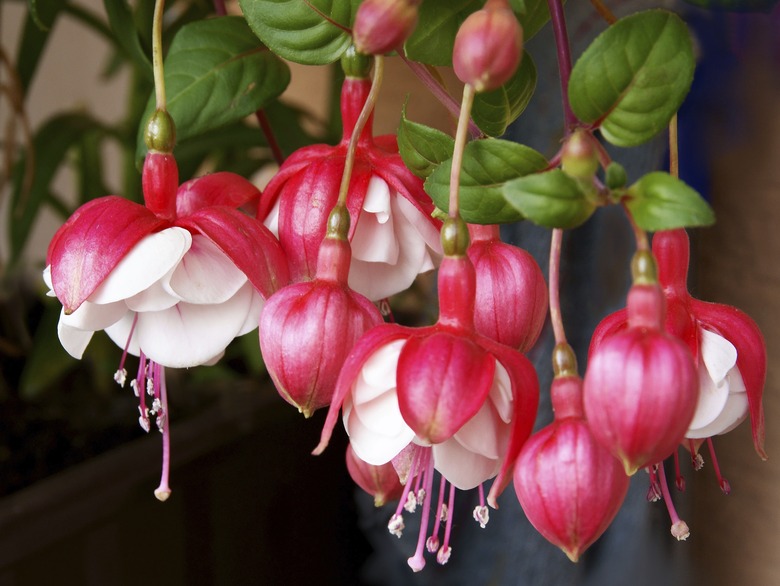When To Prune A Fuchsia
Fuchsias (Fuchsia spp.), perennial shrubs or trees that vary in height from 6 inches to 40 feet in their native South America and Central America, often are grown as container annuals elsewhere. Most sport dangling flowers in combinations of red, white, pink and purple. Because they bloom on new growth, fuchsias respond well to severe pruning, which multiplies the number of fresh shoots. Their hardiness varies from U.S. Department of Agriculture plant hardiness zones 7 through 11.
Spring Pruning of Hardy Fuchsias
Hardy fuchsias, such as Fuchsia magellicana, which grows in USDA zones 7 through 10, may die back to the ground during winter in the coldest of the areas where they are perennial. In that case, leave the dead growth in place over the winter to help protect the roots, and remove it in early spring. The plant then should sprout again from the ground.
- Fuchsias (Fuchsia spp.), Hardy fuchsias, such as Fuchsia magellicana, which grows in USDA zones 7 through 10, may die back to the ground during winter in the coldest of the areas where they are perennial.
If the top growth on your hardy fuchsia survives the winter, wait until after your last frost to prune it. Clean the blades of your pruning shears with rubbing alcohol, and cut all of the plant's shoots back to 3 or 4 inches above the ground. This should stimulate heavy flowering, but it does keep the size of the fuchsia about the same from year to year. If you want your plant to grow larger, simply trim off dead and spindly growth instead.
Autumn Pruning of Basket Fuchsias
Because most fuchsias purchased in hanging baskets have already been pinched back several times during the spring, you shouldn't need to prune them again during the summer. If you wish to keep your hanging basket of fuchsias over winter where they aren't hardy, reduce the amount you water them in late autumn. When the soil is barely damp, cut them back to about 6 to 9 inches, and remove any leaves that remain on the plants.
- If the top growth on your hardy fuchsia survives the winter, wait until after your last frost to prune it.
- Clean the blades of your pruning shears with rubbing alcohol, and cut all of the plant's shoots back to 3 or 4 inches above the ground.
Lay the basket on its side in a cardboard box lined with newspaper, on a cushion of slightly damp peat moss. Cover the basket and plants with more peat moss; close the box, and place it in an area where the temperature stays cool but above freezing, preferably between 35 and 42 degrees Fahrenheit. The peat moss and the soil in the plants' basket should be kept barely moist all winter — never soggy, but not allowed to dry out completely.
Spring Pruning of Basket Fuchsias
Remove your plants from storage at the end of winter, if you want them to be in bloom by the end of spring. Plant them in fresh potting soil and place their basket in an area — such as a greenhouse or sun room — where they will receive sunlight and high humidity. Keep in mind that fuchsias prefer somewhat cool conditions, between 55 and 75 degrees Fahrenheit.
After the plants have leafed out again, pinch off the pair of leaves at the tip of each shoot. Use your fingers to do the pinching or snip each leaf pair off with sterilized pruning shears instead. That pruning should cause the plants to produce side shoots. About two to three weeks later, when the side shoots have two pairs of leaves each, remove the pair at the tip of each of them. After another two or three weeks, perform a similar final pinching of the side shoots produced by the second pinching. The plants should begin to bloom about six to 10 weeks after that date.
- Lay the basket on its side in a cardboard box lined with newspaper, on a cushion of slightly damp peat moss.
- Keep in mind that fuchsias prefer somewhat cool conditions, between 55 and 75 degrees Fahrenheit.
- After the plants have leafed out again, pinch off the pair of leaves at the tip of each shoot.
Give your fuchsias as much sunlight as possible until about mid-April. After that point, place them where they receive sun during the morning and shade during the afternoon.
Spring Pruning of Fuchsia Cuttings
If you prefer to take cuttings from your old fuchsias in late autumn to make a completely new hanging basket instead, plant those cuttings in late January. Use four for a 10- or 12-inch basket or five for a 16-inch one. In either case, position one cutting in the center of the basket and space the others evenly around it. After each cutting has three sets of leaves, pinch off the pair at the tip of each one. Then, at two-week intervals, proceed with two more pinchings of side shoots as you would for an old basket.
- Give your fuchsias as much sunlight as possible until about mid-April.
- After that point, place them where they receive sun during the morning and shade during the afternoon.
- If you prefer to take cuttings from your old fuchsias in late autumn to make a completely new hanging basket instead, plant those cuttings in late January.
- Use four for a 10- or 12-inch basket or five for a 16-inch one.
References
- Solent Fuchsia Club: Growing Hardy Fuchsias
- Royal Horticultural Society: Fuchsia
- American Fuchsia Society: Prune Fuchsia for Beauty
- American Fuchsia Society: Fuchsia Care Calendar
- Fuchsia Flower: Overwintering Fuchsias
- Solent Fuchsia Club: Preparing Fuchsia Hanging Baskets
- Auburn University: Flowering Hanging Baskets
- The Vernon Nursery: How to Over-Winter Fuchsia Plants
- The Plant Book; Susan Page and Margaret Olds, Editors
